So according to Rowperfect, I am “on a mission to find the optimal pace when doing head races”. I liked that. I like being on a mission.
I am already on the next mission. The 1k sprint season is starting. Since the head racing, I have lost some fitness, mainly due to me not putting in the required training volume. Work. Other stuff.
So, I don’t know exactly where I am, fitness wise. A week and a half from now I will row my first Masters 1k race in the single. It would be good to have a few tries in before that. And now that I have a power meter, I can use it to help me pace the race.
Here is my line of thought:
- Start with the erg power value as a guideline. I estimate my current erg power for a 1000m (around 3:20 time) to be between 325W and 350W. On the water, everything is slower, so the race duration is longer, so I expect to end up a little lower. However, it is not given that the Empower Oarlock power values correspond exactly to the erg power. Anyway, it doesn’t matter.
- If I go out too fast, I will finish slow. If I go out too slow, I should sprint to the line to get the power average as high as possible.
- Make use of all of rowsandall.com’s data analysis power to find out as much as possible about how I did that initial 1k.
- Next time, row at the average power I achieved and use the lessons obtained in 3 (hopefully).
I made use of a gap in my schedule, after lunch and before the evening conference calls. It was a warm afternoon, a slight drizzle, 15 degrees, and flat water. Only a light wind, which turned out to be a headwind for my 1k.
I did a 3km warming up including two practice starts and a few 10 stroke bursts:
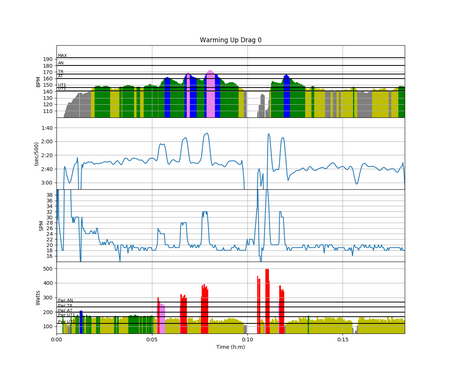
At that point I was in the buoyed 2km track, about 800m from the finish line. I mentally prepared myself for “a lot of red” (referring to the power and heart rate plots), dialed up a 1k on the SpeedCoach and got into starting position.
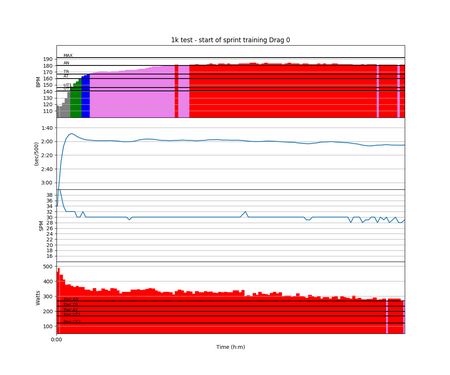
Workout Summary - media/20170425-150809-Sanders SpeedCoach 20170425 0311pmo.csv
--|Total|-Total-|--Avg--|-Avg-|Avg-|-Avg-|-Max-|-Avg
--|Dist-|-Time--|-Pace--|-Pwr-|SPM-|-HR--|-HR--|-DPS
--|01000|04:00.0|02:00.2|319.3|30.2|175.4|184.0|08.3
W-|01000|04:00.0|02:00.4|318.5|30.1|176.1|184.0|08.3
R-|00000|00:00.0|00:00.0|000.0|00.0|000.0|184.0|00.0
Workout Details
#-|SDist|-Split-|-SPace-|-Pwr-|SPM-|AvgHR|MaxHR|DPS-
00|00100|00:22.9|01:54.6|365.1|33.0|140.6|167.0|07.9
01|00100|00:23.9|01:59.5|339.1|30.0|170.6|172.0|08.4
02|00100|00:23.5|01:57.4|341.9|29.9|175.0|178.0|08.5
03|00100|00:24.0|02:00.1|328.9|30.0|179.9|181.0|08.3
04|00100|00:23.9|01:59.3|326.2|30.0|181.8|183.0|08.4
05|00100|00:24.0|01:59.9|321.1|30.2|182.8|184.0|08.3
06|00100|00:24.1|02:00.3|311.2|30.0|183.1|184.0|08.3
07|00100|00:24.5|02:02.5|294.0|29.8|182.4|183.0|08.2
08|00100|00:24.9|02:04.7|287.6|29.5|181.8|183.0|08.2
09|00100|00:25.2|02:06.1|276.6|29.1|181.0|182.0|08.2
So yes, I went out too fast. But I did obtain an average power value, and it’s 320W. As usual in a 1k row, around the 500m mark things started to fall apart. I really had trouble keeping the stroke rate at least above 30spm (where I should be at 32spm in a couple of weeks), and in the slight headwind everything just became very sluggish. I was happy though that the total time was not too far from 4 minutes. Usually, in April, my 1k OTW time is around this, and today it was into a headwind.
Below, I will add some detailed discussion of the various other metrics.
I paddled the 350m to the finish line of the 2k course, turned the boat, and continued in a light “steady state” row. During that steady state row, I did two 250m pieces, just for the fun of it, to test how 320W of power would feel at 32spm. I did one piece in tailwind where I saw 1:55-1:56 pace, and one in headwind where the pace was around 2:00.
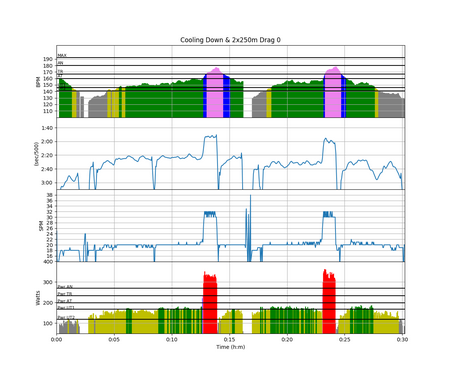
Detailed analysis
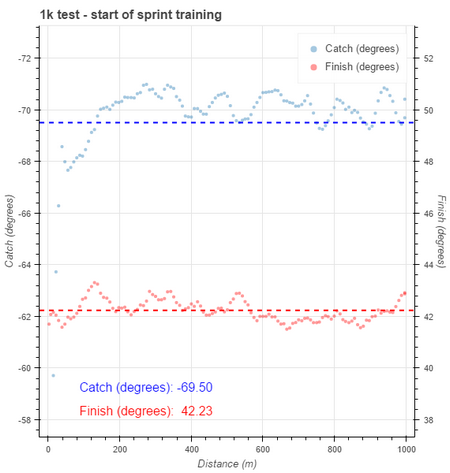
Catch angle seems high. When I first started rowing with the Empower Oarlock, I was worried about the short catch angle. Perhaps I have no the opposite problem? It seems to be an artifact of the sprint pace. The average over the entire outing is 66 degrees catch, 41 degrees finish. What you can also see is that as I got tired in the second half of the test, I shortened up on the finish. Here’s the “stroke profile” plot:
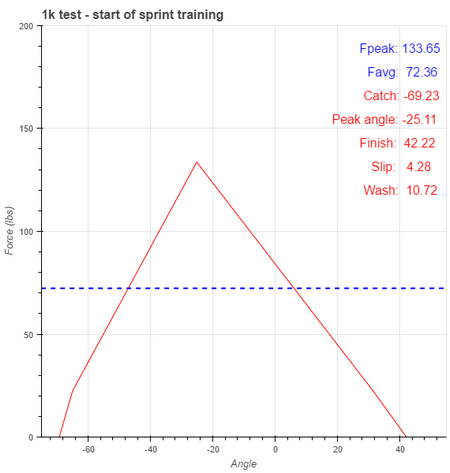
I did not watch “Wash” numbers, and not having rowed a lot in the single lately, I am a little behind on my “mission” to improve my “wash” numbers. I think I could do better on this value. Here is the story of “wash”:
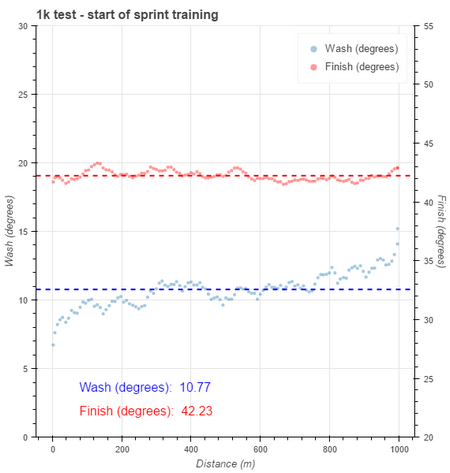
Yep, it became a sad story after 700m.
Work per stroke varied quite a lot during the row. The mean value was 648J (which is high), while the 25% and 75% boundary was at 593J and 678J respectively. So that means that more than 25% of the strokes (about 30 strokes) were at more than 678J, and about 25% of the strokes were below 593J.
For head racing, I wanted to be around 550W, and I think that is even a good value for sprint racing. At least, that’s my hypothesis, still to be confirmed. For now, I note that I should rate up and lighten up.
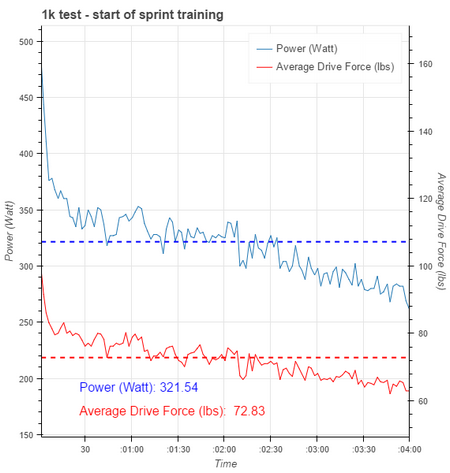
This graph (above) of power and average drive force vs time is the embarrassing one. Of course the start strokes were strong, but then I brought it down to what I thought was a good value of just under 350W, but in the headwind, after 500m, you can see exactly where the wheels came off and I reduced the average drive force, shortened up at the finish, and brought the entire power down. At this point in the race, I was looking at my power values and I didn’t know what to do. (Unfortunately, I had no additional metrics to see. Being “smart”, I had set one of the bottom screens to distance, not realizing the SpeedCoach defaults the other bottom screen to distance as well when doing pre-programmed pieces. I wish there was more control of that. I would like to set it exactly as I want it, not as NK thinks I want it.)
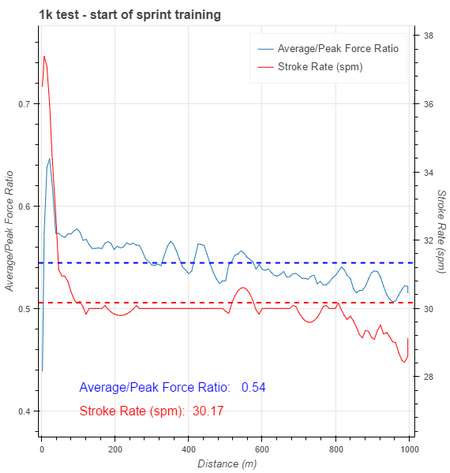
Oh well, I also dropped the rate in the final 200m. Booh, Sander!
Here are the two “250m” pieces that I did afterwards.
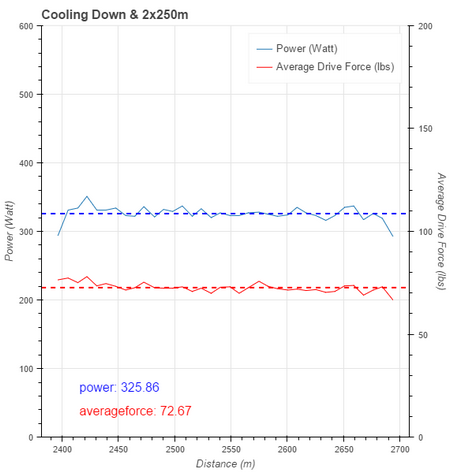
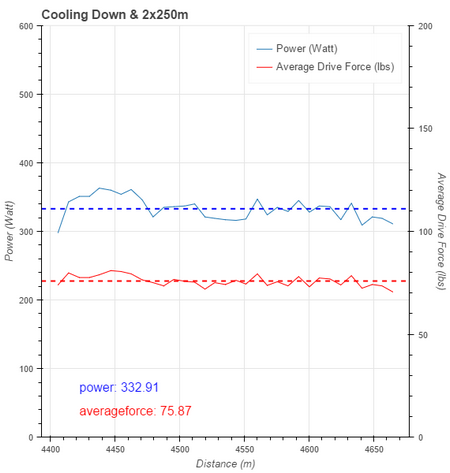
Of course these were shorter pieces, but they did feel better. I think I have a plan for my upcoming 1k race.
Also, I am still impressed by how incredibly useful these metrics are in analysing what happened, and how, if you put in a little thinking, they guide you to what is hopefully a better plan to attack the next 1k piece.
Follow me in social media
Like this:
Like Loading...
Apr 25 2017
Masters: Pacing a 1000m single scull row with a power meter
So according to Rowperfect, I am “on a mission to find the optimal pace when doing head races”. I liked that. I like being on a mission.
I am already on the next mission. The 1k sprint season is starting. Since the head racing, I have lost some fitness, mainly due to me not putting in the required training volume. Work. Other stuff.
So, I don’t know exactly where I am, fitness wise. A week and a half from now I will row my first Masters 1k race in the single. It would be good to have a few tries in before that. And now that I have a power meter, I can use it to help me pace the race.
Here is my line of thought:
I made use of a gap in my schedule, after lunch and before the evening conference calls. It was a warm afternoon, a slight drizzle, 15 degrees, and flat water. Only a light wind, which turned out to be a headwind for my 1k.
I did a 3km warming up including two practice starts and a few 10 stroke bursts:
At that point I was in the buoyed 2km track, about 800m from the finish line. I mentally prepared myself for “a lot of red” (referring to the power and heart rate plots), dialed up a 1k on the SpeedCoach and got into starting position.
Workout Summary - media/20170425-150809-Sanders SpeedCoach 20170425 0311pmo.csv
--|Total|-Total-|--Avg--|-Avg-|Avg-|-Avg-|-Max-|-Avg
--|Dist-|-Time--|-Pace--|-Pwr-|SPM-|-HR--|-HR--|-DPS
--|01000|04:00.0|02:00.2|319.3|30.2|175.4|184.0|08.3
W-|01000|04:00.0|02:00.4|318.5|30.1|176.1|184.0|08.3
R-|00000|00:00.0|00:00.0|000.0|00.0|000.0|184.0|00.0
Workout Details
#-|SDist|-Split-|-SPace-|-Pwr-|SPM-|AvgHR|MaxHR|DPS-
00|00100|00:22.9|01:54.6|365.1|33.0|140.6|167.0|07.9
01|00100|00:23.9|01:59.5|339.1|30.0|170.6|172.0|08.4
02|00100|00:23.5|01:57.4|341.9|29.9|175.0|178.0|08.5
03|00100|00:24.0|02:00.1|328.9|30.0|179.9|181.0|08.3
04|00100|00:23.9|01:59.3|326.2|30.0|181.8|183.0|08.4
05|00100|00:24.0|01:59.9|321.1|30.2|182.8|184.0|08.3
06|00100|00:24.1|02:00.3|311.2|30.0|183.1|184.0|08.3
07|00100|00:24.5|02:02.5|294.0|29.8|182.4|183.0|08.2
08|00100|00:24.9|02:04.7|287.6|29.5|181.8|183.0|08.2
09|00100|00:25.2|02:06.1|276.6|29.1|181.0|182.0|08.2
So yes, I went out too fast. But I did obtain an average power value, and it’s 320W. As usual in a 1k row, around the 500m mark things started to fall apart. I really had trouble keeping the stroke rate at least above 30spm (where I should be at 32spm in a couple of weeks), and in the slight headwind everything just became very sluggish. I was happy though that the total time was not too far from 4 minutes. Usually, in April, my 1k OTW time is around this, and today it was into a headwind.
Below, I will add some detailed discussion of the various other metrics.
I paddled the 350m to the finish line of the 2k course, turned the boat, and continued in a light “steady state” row. During that steady state row, I did two 250m pieces, just for the fun of it, to test how 320W of power would feel at 32spm. I did one piece in tailwind where I saw 1:55-1:56 pace, and one in headwind where the pace was around 2:00.
Detailed analysis
Catch angle seems high. When I first started rowing with the Empower Oarlock, I was worried about the short catch angle. Perhaps I have no the opposite problem? It seems to be an artifact of the sprint pace. The average over the entire outing is 66 degrees catch, 41 degrees finish. What you can also see is that as I got tired in the second half of the test, I shortened up on the finish. Here’s the “stroke profile” plot:
I did not watch “Wash” numbers, and not having rowed a lot in the single lately, I am a little behind on my “mission” to improve my “wash” numbers. I think I could do better on this value. Here is the story of “wash”:
Yep, it became a sad story after 700m.
Work per stroke varied quite a lot during the row. The mean value was 648J (which is high), while the 25% and 75% boundary was at 593J and 678J respectively. So that means that more than 25% of the strokes (about 30 strokes) were at more than 678J, and about 25% of the strokes were below 593J.
For head racing, I wanted to be around 550W, and I think that is even a good value for sprint racing. At least, that’s my hypothesis, still to be confirmed. For now, I note that I should rate up and lighten up.
This graph (above) of power and average drive force vs time is the embarrassing one. Of course the start strokes were strong, but then I brought it down to what I thought was a good value of just under 350W, but in the headwind, after 500m, you can see exactly where the wheels came off and I reduced the average drive force, shortened up at the finish, and brought the entire power down. At this point in the race, I was looking at my power values and I didn’t know what to do. (Unfortunately, I had no additional metrics to see. Being “smart”, I had set one of the bottom screens to distance, not realizing the SpeedCoach defaults the other bottom screen to distance as well when doing pre-programmed pieces. I wish there was more control of that. I would like to set it exactly as I want it, not as NK thinks I want it.)
Oh well, I also dropped the rate in the final 200m. Booh, Sander!
Here are the two “250m” pieces that I did afterwards.
Of course these were shorter pieces, but they did feel better. I think I have a plan for my upcoming 1k race.
Also, I am still impressed by how incredibly useful these metrics are in analysing what happened, and how, if you put in a little thinking, they guide you to what is hopefully a better plan to attack the next 1k piece.
Follow me in social mediaShare this:
Like this:
By sanderroosendaal • Uncategorized • 2 • Tags: 1000m, 1k, lake, masters, OTW, rowing, single, sprint, training